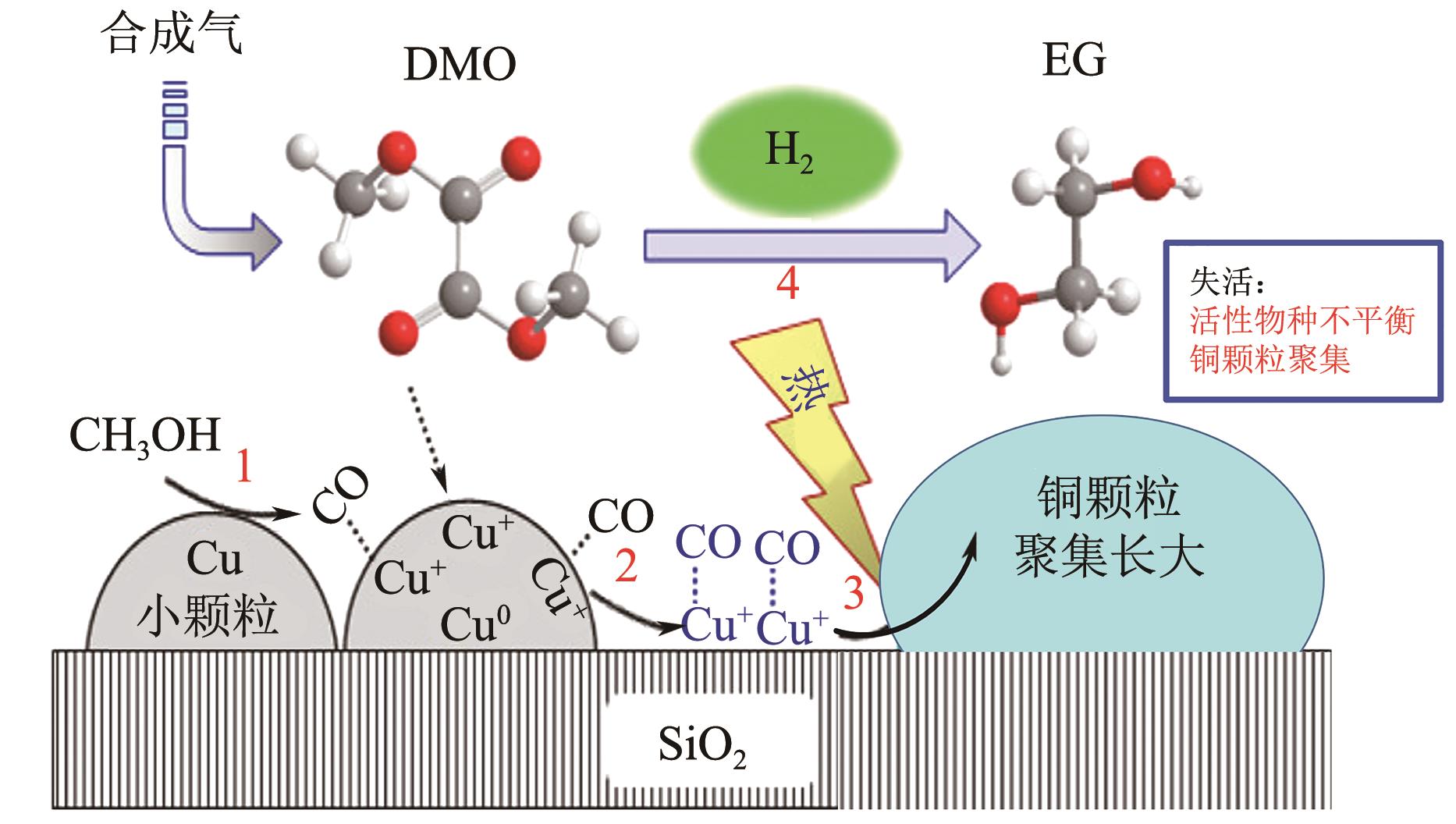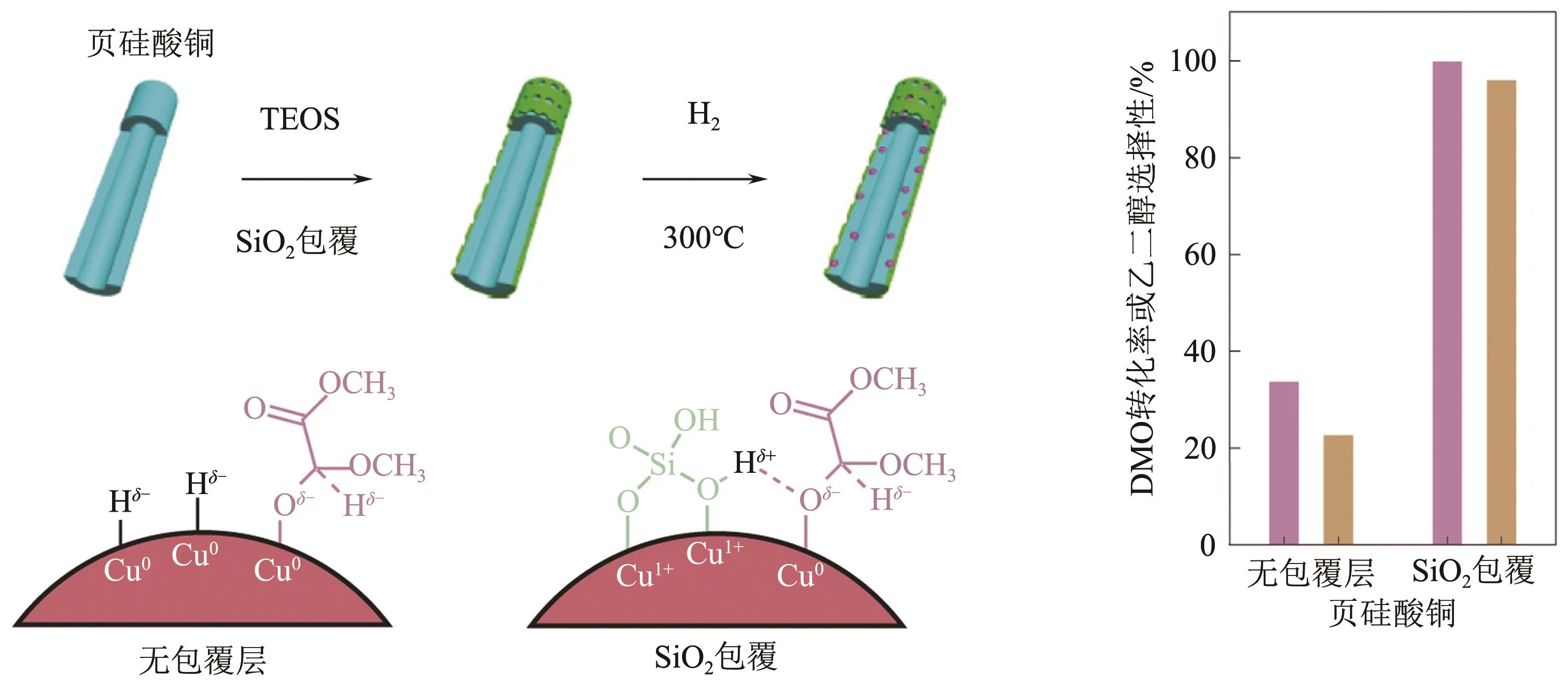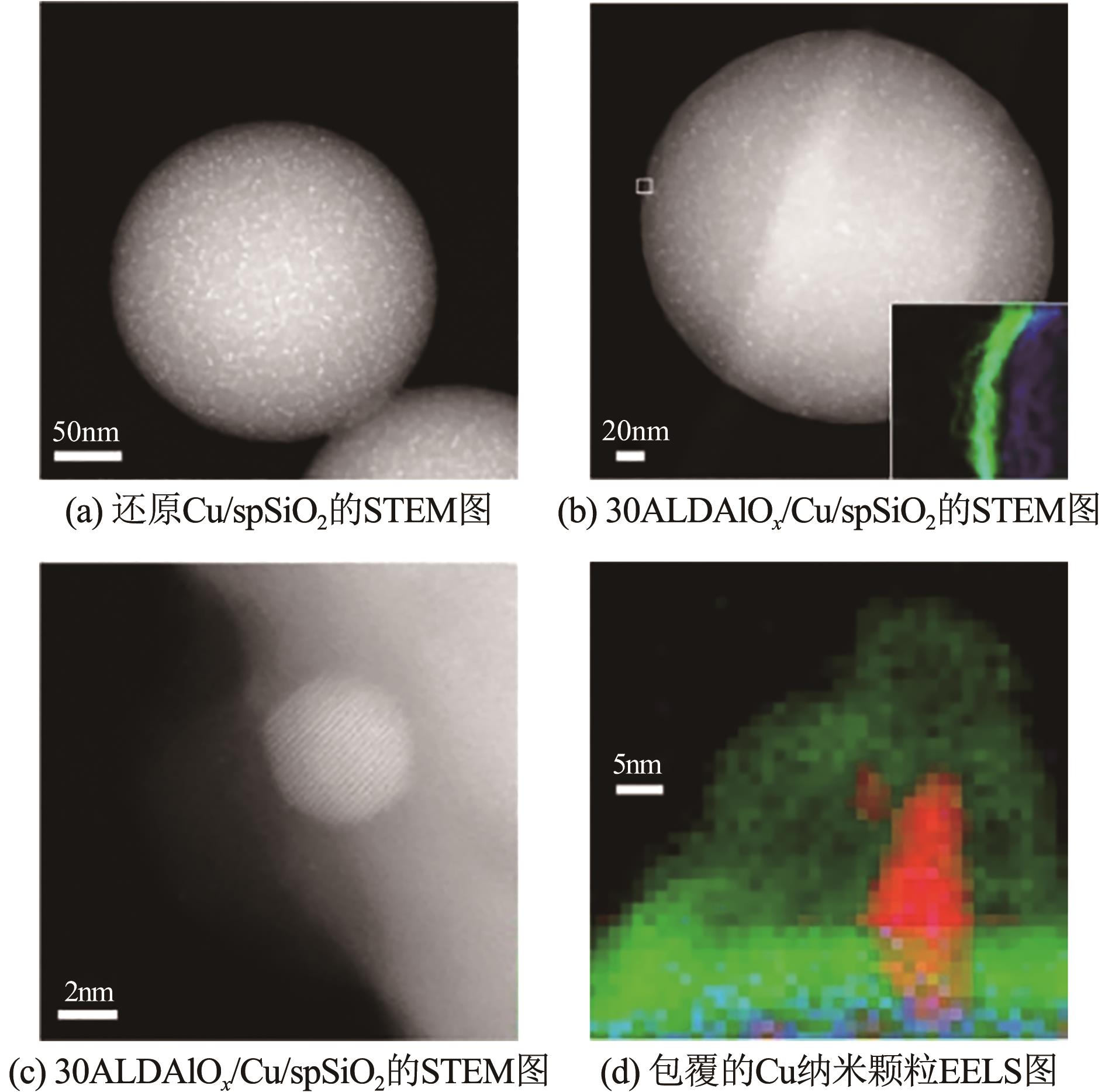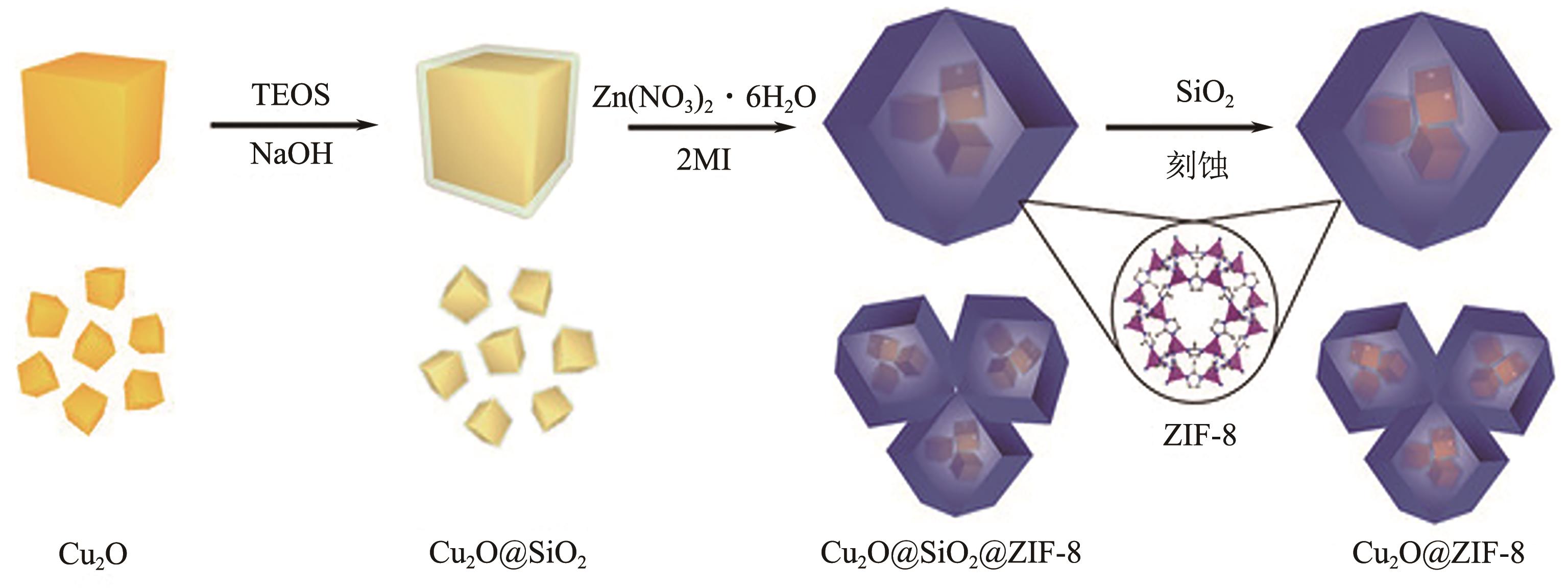化工进展 ›› 2023, Vol. 42 ›› Issue (4): 1860-1868.DOI: 10.16085/j.issn.1000-6613.2022-1007
铜催化剂在涉氢反应中的失活机制和稳定策略
殷铭1,2( ), 郭晋1,3, 庞纪峰1,2(
), 郭晋1,3, 庞纪峰1,2( ), 吴鹏飞1, 郑明远1(
), 吴鹏飞1, 郑明远1( )
)
- 1.中国科学院大连化学物理研究所,辽宁 大连 116023
2.中国科学院大学,北京 100049
3.大连交通大学,辽宁 大连 116028
-
收稿日期:2022-05-30修回日期:2022-10-22出版日期:2023-04-25发布日期:2023-05-08 -
通讯作者:庞纪峰,郑明远 -
作者简介:殷铭(1995—),男,硕士研究生,研究方向为乙醇催化转化。E-mail:yincoming@dicp.ac.cn。 -
基金资助:国家自然科学基金面上项目(21776268);国家自然科学基金创新群体项目(21721004);中国科学院先导项目(XDA 21060200)
Deactivation mechanisms and stabilizing strategies for Cu based catalysts in reactions with hydrogen
YIN Ming1,2( ), GUO Jin1,3, PANG Jifeng1,2(
), GUO Jin1,3, PANG Jifeng1,2( ), WU Pengfei1, ZHENG Mingyuan1(
), WU Pengfei1, ZHENG Mingyuan1( )
)
- 1.Dalian Institute of Chemical Physics, Chinese Academy of Sciences, Dalian 116023, Liaoning, China
2.University of Chinese Academy of Sciences, Beijing 100049, China
3.Dalian Jiaotong University, Dalian 116028, Liaoning, China
-
Received:2022-05-30Revised:2022-10-22Online:2023-04-25Published:2023-05-08 -
Contact:PANG Jifeng, ZHENG Mingyuan
摘要:
铜基催化剂对C
中图分类号:
引用本文
殷铭, 郭晋, 庞纪峰, 吴鹏飞, 郑明远. 铜催化剂在涉氢反应中的失活机制和稳定策略[J]. 化工进展, 2023, 42(4): 1860-1868.
YIN Ming, GUO Jin, PANG Jifeng, WU Pengfei, ZHENG Mingyuan. Deactivation mechanisms and stabilizing strategies for Cu based catalysts in reactions with hydrogen[J]. Chemical Industry and Engineering Progress, 2023, 42(4): 1860-1868.
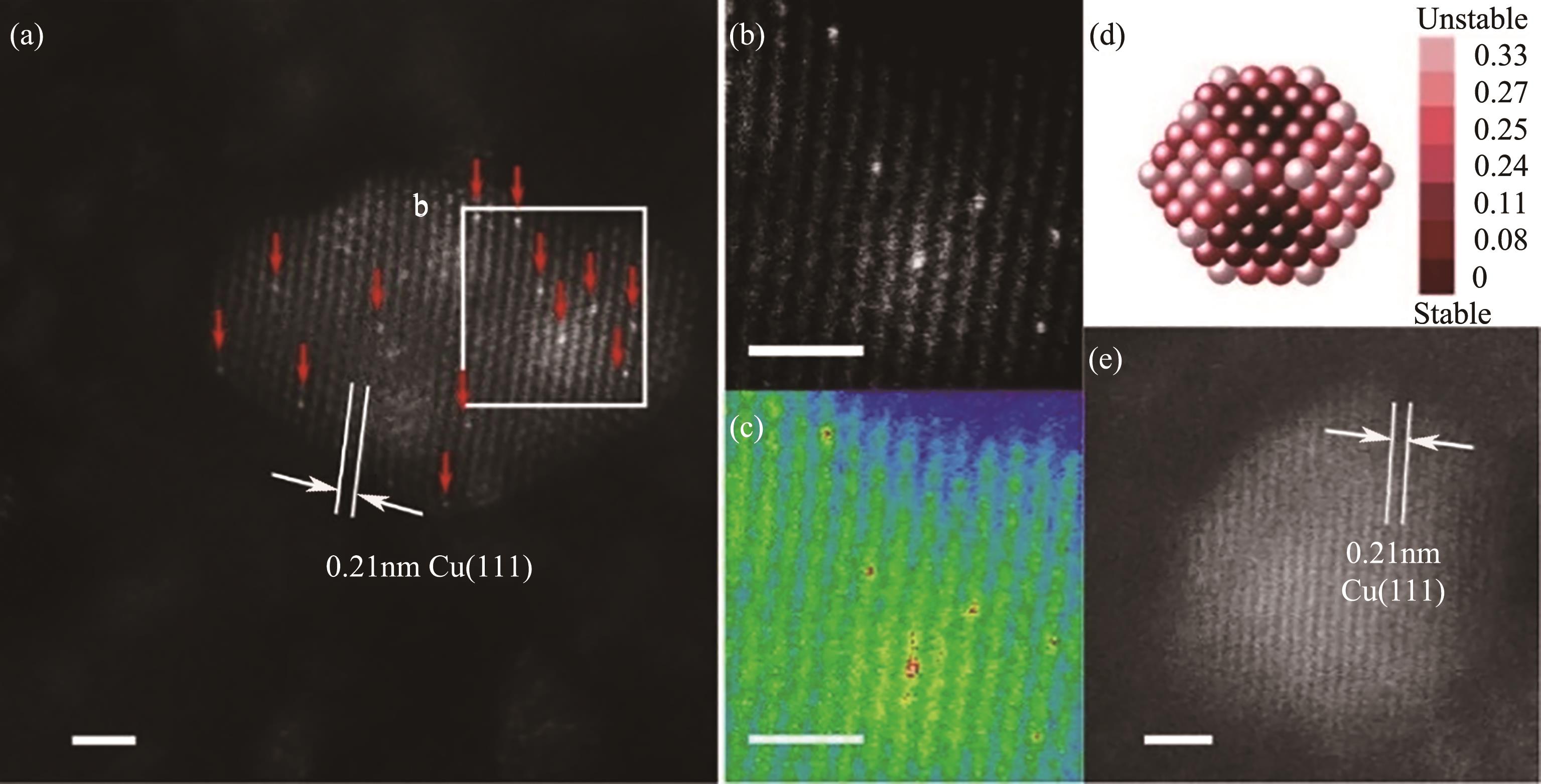
图7 0.1Pt10Cu/Al2O3单原子催化剂的HAADF-STEM图[(a),Pt以单原子形式分散在Cu晶面];(a)图的放大区域照片和颜色差异图(b,c);Pt单原子在Cu (~2.1 nm)颗粒上的稳定性[(d),暗红色为Pt原子的稳定位];10Cu/Al2O3催化剂的HAADF-STEM图[(e),标尺为1nm][79]
| 1 | OJHA N K, ZYRYANOV G V, MAJEE A, et al. Copper nanoparticles as inexpensive and efficient catalyst: A valuable contribution in organic synthesis[J]. Coordination Chemistry Reviews, 2017, 353: 1-57. |
| 2 | GAWANDE M B, GOSWAMI A, FELPIN F, et al. Cu and Cu-based nanoparticles: Synthesis and applications in catalysis[J]. Chemical Reviews, 2016, 116(6): 3722-3811. |
| 3 | YE Runping, LIN Ling, LI Qiaohong, et al. Recent progress in improving the stability of copper-based catalysts for hydrogenation of carbon-oxygen bonds[J]. Catalysis Science & Technology, 2018, 8(14): 3428-3449. |
| 4 | 张卿源, 舒静. 铜基催化剂的失活再生研究进展[J]. 化工科技, 2019, 27(3): 65-69. |
| ZHANG Qingyuan, SHU Jing. Progress in deactivation and regeneration of Cu based catalysts[J]. Science & Technology in Chemical Industry, 2019, 27(3): 65-69. | |
| 5 | BARTHOLOMEW C H. Mechanisms of catalyst deactivation[J]. Applied Catalysis A: General, 2001, 212(1/2): 17-60. |
| 6 | BARTHOLOMEW C H, ARGYLE M D. Advances in catalyst deactivation and regeneration[J]. Catalysts, 2015, 5(2): 949-954. |
| 7 | FROMENT G F. Modeling of catalyst deactivation[J]. Applied Catalysis A: General, 2001, 212(1/2): 117-128. |
| 8 | CAO Anmin, LU Rongwen, Götz VESER. Stabilizing metal nanoparticles for heterogeneous catalysis[J]. Physical Chemistry Chemical Physics, 2010, 12(41): 13499-13510. |
| 9 | BUFFAT P, BOREL J P. Size effect on the melting temperature of gold particles[J]. Physical Review A, 1976, 13(6): 2287-2298. |
| 10 | OUYANG Runhai, LIU Jinxun, LI Weixue. Atomistic theory of Ostwald ripening and disintegration of supported metal particles under reaction conditions[J]. Journal of the American Chemical Society, 2013, 135(5): 1760-1771. |
| 11 | HU Sulei, LI Weixue. Sabatier principle of metal-support interaction for design of ultrastable metal nanocatalysts[J]. Science, 2021, 374(6573): 1360-1365. |
| 12 | 张博, 张素华, 惠胜国, 等. 草酸二甲酯加氢制乙二醇Cu/SiO2催化剂失活机理的研究[J]. 天然气化工(C1化学与化工), 2012, 37(4): 1-6. |
| ZHANG Bo, ZHANG Suhua, HUI Shengguo, et al. Study on deactivation mechanism of Cu/SiO2 catalyst for hydrogenation of dimethyl oxalate to ethylene glycol[J]. Natural Gas Chemical Industry, 2012, 37(4): 1-6. | |
| 13 | ZHENG Jianwei, ZHOU Junfu, LIN Haiqiang, et al. CO-mediated deactivation mechanism of SiO2-supported copper catalysts during dimethyl oxalate hydrogenation to ethylene glycol[J]. The Journal of Physical Chemistry C, 2015, 119(24): 13758-13766. |
| 14 | CHEN Zheng, GE Hui, WANG Pengfei, et al. Insight into the deactivation mechanism of water on active Cu species for ester hydrogenation: Experimental and theoretical study[J]. Molecular Catalysis, 2020, 488: 110919. |
| 15 | DING Jie, POPA Tiberiu, TANG Jinke, et al. Highly selective and stable Cu/SiO2 catalysts prepared with a green method for hydrogenation of diethyl oxalate into ethylene glycol[J]. Applied Catalysis B: Environmental, 2017, 209: 530-542. |
| 16 | 陈明旭, 梅占强, 陈柯臻, 等. Cu基催化剂催化甲醇水蒸气重整制氢研究进展[J]. 石油化工, 2017, 46(12): 1536-1541. |
| CHEN Mingxu, MEI Zhanqiang, CHEN Kezheng, et al. The research development of methanol steam reforming for hydrogen production on copper based catalyst[J]. PetrochemicaL Technology, 2017, 46(12): 1536-1541. | |
| 17 | MESILOV V, DAHLIN S, BERGMAN S L, et al. Insights into sulfur poisoning and regeneration of Cu-SSZ-13 catalysts: in situ Cu and S K-edge XAS studies[J]. Catalysis Science & Technology, 2021, 11(16): 5619-5632. |
| 18 | BEALE A M, GIBSON E K, O'BRIEN M G, et al. Chemical imaging of the sulfur-induced deactivation of Cu/ZnO catalyst bodies[J]. Journal of Catalysis, 2014, 314: 94-100. |
| 19 | TWIGG Martyn V, SPENCER M S. Deactivation of supported copper metal catalysts for hydrogenation reactions[J]. Applied Catalysis A: General, 2001, 212(1): 161-174. |
| 20 | 李胜军. 草酸二甲酯加氢制乙二醇Cu/SiO2催化剂粉化原因浅析[J]. 河南化工, 2017, 34(4): 44-46. |
| LI Shengjun. Analysis on the chalking of Cu/SiO2 catlysts for hydrogeaniton of dimethylxoaiate to ethylene glcyol[J]. Henan Chemical Industry, 2017, 34(4): 44-46. | |
| 21 | WANG Lingxiang, WANG Liang, MENG Xiangju, et al. New strategies for the preparation of sinter-resistant metal-nanoparticle-based catalysts[J]. Advanced Materials, 2019, 31(50): 1901905. |
| 22 | TOUPANCE Thierry, KERMAREC Maggy, LAMBERT Jean-François, et al. Conditions of formation of copper phyllosilicates in silica-supported copper catalysts prepared by selective adsorption[J]. Journal of Physical Chemistry B, 2002, 106(9): 2277-2286. |
| 23 | LIN Haiqiang, ZHENG Xinlei, HE Zhe, et al. Cu/SiO2 hybrid catalysts containing HZSM-5 with enhanced activity and stability for selective hydrogenation of dimethyl oxalate to ethylene glycol[J]. Applied Catalysis A: General, 2012, 445: 287-296. |
| 24 | ZHU Shanhui, GAO Xiaoqing, ZHU Yulei, et al. A highly efficient and robust Cu/SiO2 catalyst prepared by the ammonia evaporation hydrothermal method for glycerol hydrogenolysis to 1,2-propanediol[J]. Catalysis Science & Technology, 2015, 5(2): 1169-1180. |
| 25 | WANG Zhiqiao, XU Zhongning, PENG Siyan, et al. High-performance and long-lived Cu/SiO2 nanocatalyst for CO2 hydrogenation[J]. ACS Catalysis, 2015, 5(7): 4255-4259. |
| 26 | PANG Jifeng, ZHENG Mingyuan, WANG Chan, et al. Hierarchical echinus-like Cu-MFI catalysts for ethanol dehydrogenation[J]. ACS Catalysis, 2020, 10(22): 13624-13629. |
| 27 | GONG Jinlong, YUE Hairong, ZHAO Yujun, et al. Synthesis of ethanol via syngas on Cu/SiO2 catalysts with balanced Cu0-Cu+ sites[J]. Journal of the American Chemical Society, 2012, 134(34): 13922-13925. |
| 28 | YUE Hairong, ZHAO Yujun, ZHAO Shuo, et al. A copper-phyllosilicate core-sheath nanoreactor for carbon-oxygen hydrogenolysis reactions[J]. Nature Communications, 2013, 4(1): 2339. |
| 29 | YUE Hairong, MA Xinbin, GONG Jinlong. An alternative synthetic approach for efficient catalytic conversion of syngas to ethanol[J]. Accounts of Chemical Research, 2014, 47(5): 1483-1492. |
| 30 | JIN R, EASA J, O'BRIEN C P. Highly active CuO x /SiO2 dot core/rod shell catalysts with enhanced stability for the reverse water gas shift reaction[J]. ACS Applied Materials & Interfaces, 2021, 13(32): 38213-38220. |
| 31 | XU Chaofa, CHEN Guangxu, ZHAO Yun, et al. Interfacing with silica boosts the catalysis of copper[J]. Nature Communications, 2018, 9(1): 3367. |
| 32 | FAN Ruoyu, ZHANG Yange, HU Zhi, et al. Synergistic catalysis of cluster and atomic copper induced by copper-silica interface in transfer-hydrogenation[J]. Nano Research, 2021, 14(12): 4601-4609. |
| 33 | 贾晨喜, 邵敬爱, 白小薇, 等. 二氧化碳加氢制甲醇铜基催化剂性能的研究进展[J]. 化工进展, 2020, 39(9): 3658-3668. |
| JIA Chenxi, SHAO Jing’ai, BAI Xiaowei, et al. Review on Cu-based catalysts for CO2 hydrogenation to methanol[J]. Chemical Industry and Engineering Progress, 2020, 39(9): 3658-3668. | |
| 34 | BAHMANPOUR A M, HÉROGUEL F, KILIÇ M, et al. Cu-Al spinel as a highly active and stable catalyst for the reverse water gas shift reaction[J]. ACS Catalysis, 2019, 9(7): 6243-6251. |
| 35 | SHAO Yuewen, WANG Junzhe, DU Huining, et al. Importance of magnesium in Cu-based catalysts for selective conversion of biomass-derived furan compounds to diols[J]. ACS Sustainable Chemistry & Engineering, 2020, 8(13): 5217-5228. |
| 36 | VAN DEELEN T W, HERNÁNDEZ MEJÍA C, DE JONG K P. Control of metal-support interactions in heterogeneous catalysts to enhance activity and selectivity[J]. Nature Catalysis, 2019, 2(11): 955-970. |
| 37 | 赵鹬, 王世栋, 贠宏飞, 等. 草酸二甲酯加氢反应中铜催化剂稳定性的研究进展[J]. 化工进展, 2018, 37(9): 3393-3400. |
| ZHAO Yu, WANG Shidong, YUAN Hongfei, et al. Recent progress on the stabilization of copper catalysts for the hydrogenation of dimethyl oxalate[J]. Chemical Industry and Engineering Progress, 2018, 37(9): 3393-3400. | |
| 38 | ZHAO Shuo, YUE Hairong, ZHAO Yujun, et al. Chemoselective synthesis of ethanol via hydrogenation of dimethyl oxalate on Cu/SiO2: Enhanced stability with boron dopant[J]. Journal of Catalysis, 2013, 297: 142-150. |
| 39 | XU Yuxi, KONG Lingxin, HUANG Huijiang, et al. Promotional effect of indium on Cu/SiO2 catalysts for the hydrogenation of dimethyl oxalate to ethylene glycol[J]. Catalysis Science & Technology, 2021, 11(20): 6854-6865. |
| 40 | YE Chenliang, GUO Cuili, ZHANG Jinli. Highly active and stable CeO2-SiO2 supported Cu catalysts for the hydrogenation of methyl acetate to ethanol[J]. Fuel Processing Technology, 2016, 143: 219-224. |
| 41 | YE Chenliang, GUO Cuili, SUN Chengwei, et al. Effect of Mn doping on the activity and stability of Cu-SiO2 catalysts for the hydrogenation of methyl acetate to ethanol[J]. RSC Advances 2016, 6(114): 113796-113802. |
| 42 | HUANG Jingjing, DING Tong, MA Kui, et al. Modification of Cu/SiO2 catalysts by La2O3 to quantitatively tune Cu+-Cu0 dual sites with improved catalytic activities and stabilities for dimethyl ether steam reforming[J]. ChemCatChem, 2018, 10(17): 3862-3871. |
| 43 | PU Yunchuan, LI Shuirong, YAN Shuai, et al. An improved Cu/ZnO catalyst promoted by Sc2O3 for hydrogen production from methanol reforming[J]. Fuel, 2019, 241: 607-615. |
| 44 | SUN Peiyong, WANG Haixing, LUO Xueqing, et al. Sintering-resistant Cu/B/Ca/Al2O3 catalysts for durable hydrogenation of sec-butyl acetate to 2-butanol and ethanol[J]. Journal of Industrial and Engineering Chemistry, 2019, 74: 86-95. |
| 45 | BEERTHUIS R, VISSER N L, HOEVEN J E S, et al. Manganese oxide promoter effects in the copper-catalyzed hydrogenation of ethyl acetate[J]. Journal of Catalysis, 2021, 394: 307-315. |
| 46 | JIMENEZ-GOMEZ C P, CECILIA J A, DURAN-MARTIN D, et al. Gas-phase hydrogenation of furfural to furfuryl alcohol over Cu/ZnO catalysts[J]. Journal of Catalysis, 2016, 336: 107-115. |
| 47 | JIMENEZ-GOMEZ C P, CECILIA J A, MARQUEZ-RODRIGUEZ I, et al. Gas-phase hydrogenation of furfural over Cu/CeO2 catalysts[J]. Catalysis Today, 2017, 279: 327-338. |
| 48 | ZHANG Xiaopei, ZHU Xiaobing, LIN Lili, et al. Highly dispersed copper over β-Mo2C as an efficient and stable catalyst for the reverse water gas shift (RWGS) reaction[J]. ACS Catalysis, 2017, 7: 912-918. |
| 49 | YU Jiafeng, SUN Xingtao, TONG Xin, et al. Ultra-high thermal stability of sputtering reconstructed Cu-based catalysts[J]. Nature Communications, 2021, 12: 7209. |
| 50 | XIN Yue, YU Kaifu, ZHANG Lantian, et al. Copper-based plasmonic catalysis: Recent advances and future perspectives[J]. Advanced Materials, 2021, 33: 2008145. |
| 51 | WANG Shenghua, FENG Kai, ZHANG Dake, et al. Stable Cu catalysts supported by two-dimensional SiO2 with strong metal-support interaction[J]. Advanced Science, 2022, 9(9): 2104972. |
| 52 | OTOR H O, STEINER J B, GARCIA-SANCHO C, et al. Encapsulation methods for control of catalyst deactivation: A review[J]. ACS Catalysis, 2020, 10(14): 7630-7656. |
| 53 | HUO J, TESSONNIER J, SHANKS B H. Improving hydrothermal stability of supported metal catalysts for biomass conversions: A review[J]. ACS Catalysis, 2021, 11(9): 5248-5270. |
| 54 | GEORGE S M. Atomic layer deposition: An overview[J]. Chemical Reviews, 2010, 110(1): 111-131. |
| 55 | ZHANG Bin, QIN Yong. Interface tailoring of heterogeneous catalysts by atomic layer deposition[J]. ACS Catalysis, 2018, 8(11): 10064-10081. |
| 56 | O'NEILL B J, JACKSON D H K, CRISCI A J, et al. Stabilization of copper catalysts for liquid-phase reactions by atomic layer deposition[J]. Angewandte Chemie International Edition, 2013, 52(51): 13808-13812. |
| 57 | ALBA-RUBIO A C, O’NEILL B J, SHI F, et al. Pore structure and bifunctional catalyst activity of overlayers applied by atomic layer deposition on copper nanoparticles[J]. ACS Catalysis, 2014, 4(5): 1554-1557. |
| 58 | ZHANG H, LEI Y, KROPF A J, et al. Enhancing the stability of copper chromite catalysts for the selective hydrogenation of furfural using ALD overcoating[J]. Journal of Catalysis, 2014, 317: 284-292. |
| 59 | HÉROGUEL F, LE MONNIER B P, BROWN K S, et al. Catalyst stabilization by stoichiometrically limited layer-by-layer overcoating in liquid media[J]. Applied Catalysis B-Environmental, 2017, 218: 643-649. |
| 60 | HUANG Xiumin, MA Meng, MIAO Shu, et al. Hydrogenation of methyl acetate to ethanol over a highly stable Cu/SiO2 catalyst: Reaction mechanism and structural evolution[J]. Applied Catalysis A-General, 2017, 531: 79-88. |
| 61 | ZHU Qiufeng, ZHANG Qingcheng, WEN Lixiong. Anti-sintering silica-coating CuZnAlZr catalyst for methanol synthesis from CO hydrogenation[J]. Fuel Processing Technology, 2017, 156: 280-289. |
| 62 | PACHFULE Pradip, YANG Xinchun, ZHU Qilong, et al. From Ru nanoparticle-encapsulated metal-organic frameworks to highly catalytically active Cu/Ru nanoparticle-embedded porous carbon[J]. Journal of Materials Chemistry A, 2017, 5(10): 4835-4841. |
| 63 | LI Bo, MA Jiangong, CHENG Peng. Silica-protection-assisted encapsulation of Cu2O nanocubes into a metal-organic framework (ZIF-8) To provide a composite catalyst[J]. Angewandte Chemie International Edition, 2018, 57(23): 6834-6837. |
| 64 | CUI Wengang, LI Yanting, YU Lei, et al. Zeolite-encapsulated ultrasmall Cu/ZnO x nanoparticles for the hydrogenation of CO2 to methanol[J]. ACS Applied Materials & Interfaces, 2021, 13(16): 18693-18703. |
| 65 | CUI Wengang, HU Tongliang. Incorporation of active metal species in crystalline porous materials for highly efficient synergetic catalysis[J]. Small, 2021, 17: 2003971. |
| 66 | DING Liping, SHI Taotao, GU Jing, et al. CO2 hydrogenation to ethanol over Cu@Na-Beta[J]. Chem, 2020, 6(10): 2673-2689. |
| 67 | LAN Fujun, AARONS Jolyon, SHU Yu, et al. Anchoring strategy for highly active copper nanoclusters in hydrogenation of renewable biomass-derived compounds[J]. Applied Catalysis B: Environmental, 2021, 299: 120651. |
| 68 | WENG Mingwei, ZHANG Zihao, OKEJIRI Francis, et al. Encapsulation of CuO nanoparticles within silicalite-1 as a regenerative catalyst for transfer hydrogenation of furfural[J]. iScience, 2021, 24(8): 102884. |
| 69 | CAO Peng, LIN Lu, QI Haifeng, et al. Zeolite-encapsulated Cu nanoparticles for the selective hydrogenation of furfural to furfuryl alcohol[J]. ACS Catalysis, 2021, 11(16): 10246-10256. |
| 70 | LIN Lu, CAO Peng, PANG Jifeng, et al. Zeolite-encapsulated Cu nanoparticles with enhanced performance for ethanol dehydrogenation[J]. Journal of Catalysis, 2022, 413: 565-574. |
| 71 | SHENG Haibing, ZHANG Haitao, MA Hongfang, et al. An effective Cu-Ag/HMS bimetallic catalyst for hydrogenation of methyl acetate to ethanol[J]. Catalysis Today, 2020, 358: 122-128. |
| 72 | LIU Yanting, DING Jian, YANG Jieyong, et al. Stabilization of copper catalysts for hydrogenation of dimethyl oxalate by deposition of Ag clusters on Cu nanoparticles[J]. Catalysis Communications, 2017, 98: 43-46. |
| 73 | Engtoon SAW, OEMAR Usman, Mingli ANG, et al. Highly active and stable bimetallic nickel-copper core-ceria shell catalyst for high-temperature water-gas shift reaction[J]. ChemCatChem, 2015, 7(20): 3358-3367. |
| 74 | ZHANG Riguang, LIU Fu, WANG Baojun. Co-decorated Cu alloy catalyst for C2 oxygenate and ethanol formation from syngas on Cu-based catalyst: insight into the role of Co and Cu as well as the improved selectivity[J]. Catalysis Science & Technology, 2016, 6: 8036-8054. |
| 75 | FREI Elias, GAUR Abhijeet, LICHTENBERG Henning, et al. Cu-Zn alloy formation as unfavored state for efficient methanol catalysts [J]. ChemCatChem, 2020, 12: 4029-4033. |
| 76 | WANG Zhinuo, YIN Ming, PANG Jifeng, et al. Active and stable Cu doped NiMgAlO catalysts for upgrading ethanol to n-butanol [J]. Journal of Energy Chemistry, 2022, 72: 306-317. |
| 77 | SHAN Junjun, LIU Jilei, LI Mengwei, et al. NiCu single atom alloys catalyze the C—H bond activation in the selective non-oxidative ethanol dehydrogenation reaction[J]. Applied Catalysis B: Environmental, 2018, 226: 534-543. |
| 78 | WANG Z, HOYT R A., EL-SODA M, et al. Dry dehydrogenation of ethanol on Pt-Cu single atom alloys[J]. Topics in Catalysis, 2018, 61(5): 328-335. |
| 79 | SUN Guodong, ZHAO Zhijian, MU Rentao, et al. Breaking the scaling relationship via thermally stable Pt/Cu single atom alloys for catalytic dehydrogenation[J]. Nature Communications, 2018, 9(1): 4454. |
| 80 | AN Bing, ZHANG Jingzheng, CHENG Kang, et al. Confinement of ultrasmall Cu/ZnO x nanoparticles in metal-organic frameworks for selective methanol synthesis from catalytic hydrogenation of CO2 [J]. Journal of the American Chemical Society, 2017, 139(10): 3834-3840. |
| 81 | WANG Aiqin, LI Jun, ZHANG Tao. Heterogeneous single-atom catalysis[J]. Nature Reviews Chemistry, 2018, 2(6): 65-81. |
| 82 | YANG Tang, MAO Xinnan, ZHANG Ying, et al. Coordination tailoring of Cu single sites on C3N4 realizes selective CO2 hydrogenation at low temperature[J]. Nature Communications, 2021, 12(1): 6022. |
| [1] | 张明焱, 刘燕, 张雪婷, 刘亚科, 李从举, 张秀玲. 非贵金属双功能催化剂在锌空气电池研究进展[J]. 化工进展, 2023, 42(S1): 276-286. |
| [2] | 时永兴, 林刚, 孙晓航, 蒋韦庚, 乔大伟, 颜彬航. 二氧化碳加氢制甲醇过程中铜基催化剂活性位点研究进展[J]. 化工进展, 2023, 42(S1): 287-298. |
| [3] | 谢璐垚, 陈崧哲, 王来军, 张平. 用于SO2去极化电解制氢的铂基催化剂[J]. 化工进展, 2023, 42(S1): 299-309. |
| [4] | 杨霞珍, 彭伊凡, 刘化章, 霍超. 熔铁催化剂活性相的调控及其费托反应性能[J]. 化工进展, 2023, 42(S1): 310-318. |
| [5] | 高雨飞, 鲁金凤. 非均相催化臭氧氧化作用机理研究进展[J]. 化工进展, 2023, 42(S1): 430-438. |
| [6] | 王乐乐, 杨万荣, 姚燕, 刘涛, 何川, 刘逍, 苏胜, 孔凡海, 朱仓海, 向军. SCR脱硝催化剂掺废特性及性能影响[J]. 化工进展, 2023, 42(S1): 489-497. |
| [7] | 邓丽萍, 时好雨, 刘霄龙, 陈瑶姬, 严晶颖. 非贵金属改性钒钛基催化剂NH3-SCR脱硝协同控制VOCs[J]. 化工进展, 2023, 42(S1): 542-548. |
| [8] | 程涛, 崔瑞利, 宋俊男, 张天琪, 张耘赫, 梁世杰, 朴实. 渣油加氢装置杂质沉积规律与压降升高机理分析[J]. 化工进展, 2023, 42(9): 4616-4627. |
| [9] | 王晋刚, 张剑波, 唐雪娇, 刘金鹏, 鞠美庭. 机动车尾气脱硝催化剂Cu-SSZ-13的改性研究进展[J]. 化工进展, 2023, 42(9): 4636-4648. |
| [10] | 王鹏, 史会兵, 赵德明, 冯保林, 陈倩, 杨妲. 过渡金属催化氯代物的羰基化反应研究进展[J]. 化工进展, 2023, 42(9): 4649-4666. |
| [11] | 张启, 赵红, 荣峻峰. 质子交换膜燃料电池中氧还原反应抗毒性电催化剂研究进展[J]. 化工进展, 2023, 42(9): 4677-4691. |
| [12] | 葛全倩, 徐迈, 梁铣, 王凤武. MOFs材料在光电催化领域应用的研究进展[J]. 化工进展, 2023, 42(9): 4692-4705. |
| [13] | 王伟涛, 鲍婷玉, 姜旭禄, 何珍红, 王宽, 杨阳, 刘昭铁. 醛酮树脂基非金属催化剂催化氧气氧化苯制备苯酚[J]. 化工进展, 2023, 42(9): 4706-4715. |
| [14] | 葛亚粉, 孙宇, 肖鹏, 刘琦, 刘波, 孙成蓥, 巩雁军. 分子筛去除VOCs的研究进展[J]. 化工进展, 2023, 42(9): 4716-4730. |
| [15] | 朱传强, 茹晋波, 孙亭亭, 谢兴旺, 李长明, 高士秋. 固体高分子脱硝剂选择性非催化还原NO x 特性[J]. 化工进展, 2023, 42(9): 4939-4946. |
| 阅读次数 | ||||||
|
全文 |
|
|||||
|
摘要 |
|
|||||


